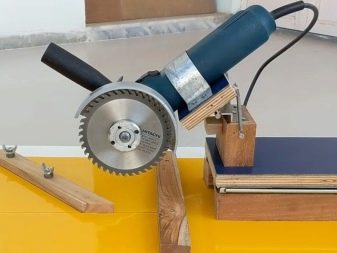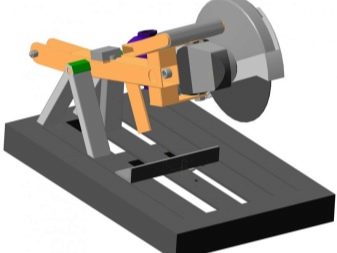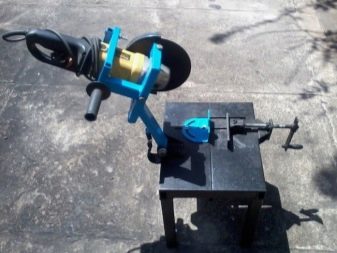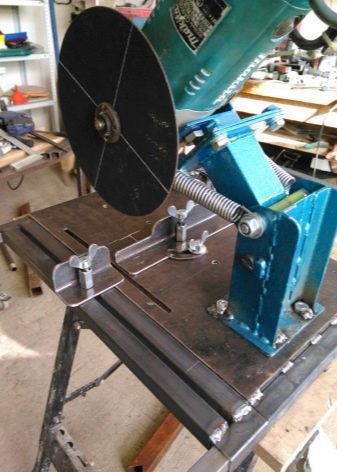Making a cutting machine from a grinder with your own hands

Angle grinder (aka "Bulgarian") is a simple and versatile hand tool. But handling angle grinders requires a steady hand and an excellent eye. A disc that is suddenly jammed in the material not only pulls the cutting line to the side, but can also collapse, which is dangerous.
On the other hand, stationary saws are large and massive. It is not easy to drag them directly to the place of work. To combine the advantages of a grinder and a stationary circular saw will help a compact device - the attachment, allowing you to firmly fix the grinder and use it as a miter or even a circular saw.
The material to be processed will be firmly fixed on the machine table. Our angle grinder, securely fixed on the bed, will act as a working tool. This will allow you to quickly and safely cut materials strictly along the marking lines.


Tools and materials
The most durable and comfortable construction of the machine is made of metal. For such a design, you need to prepare:
- a metal sheet;
- metal profile (for example, corner or channel);
- pieces of metal pipes;
- steel bars.
From the tool you will need:
- the Bulgarian herself;
- cutting discs for metal;
- cleaning discs;
- drill;
- drills for metal;
- welding machine.


You can do without welding. Well-planned and neatly locked bolted connections hold no less firmly. But if possible, it is preferable to use welded joints. This guarantees not only strength, but also the accuracy of the design.
If welding and metal rolling are not at hand, examples of strong and reliable structures of a wood cutting machine are known. You will need:
- plywood sheet with a thickness of 8 ... 12 mm;
- hardwood bar;
- strong and massive door hinges.
But plastic is unlikely to be useful to us. Although plastic products are easy to handle and look good, they are not very durable. The most unpleasant thing is that the plastic quickly loses its shape. And for a cutting machine, the rigidity of the structure is important. This guarantees an accurate and safe cut.


How to do it?
To make a cutting machine from a grinder with our own hands, we need to fix an angle grinder on a bed or swing arm. The table on which the material to be processed must be large enough.
The mechanism that secures the material to the table and secures the grinder to the frame must be strong and accurate. This will ensure not only a smooth cut, but also safety during work.
If metal is used for the structure, it is better to make the joints welded. Bolted connections are also quite strong, but they tend to loosen and shift during operation.
In any case, the wooden structure will be assembled with metal hinges, corners or screws. All connections of parts must be carefully thought out and fixed. Bolted and screwed connections must be secured with split washers or castellated nuts. It is better to glue the screws and screws entering the wood. This will, of course, make repairs impossible, but wooden structures are usually easier to rebuild based on operating experience.




Blueprints
On the Internet, it is easy to find drawings of beds of various shapes and designs. They are unlikely to be useful unchanged.It all depends on what materials are at your disposal, as well as what are the shapes and sizes of your angle grinder.
In any case, it is useful to pay attention to what designs were obtained from different materials from different craftsmen. Then choose the appropriate option and take it as a basis. But you should not neglect the design. Drawings, carefully drawn up at the design stage, may not describe your design in detail, but they will save you from offensive mistakes and mistakes.


A circular saw
When designing a machine for use as a stationary saw, you can immediately think about the design of a circular saw. Such a machine uses a large base table as the basis of the structure. A slot is made approximately in the middle of the table. Below, under the tabletop, the saw blade fastening and drive mechanism is fixedly fixed.
We can even use a sturdy wooden table. The cut for the saw blade should be 10–15 mm wide. Below, under the table top, a "grinder" is fixed without a protective casing (it will only interfere). Fastening the angle grinder should provide for a solid fixation of the grinder, but be able to quickly disconnect the unit.
Since the saw blade with the drive is rigidly fixed in the table structure, the material is moved over the table top simply by hand. This does not provide an accurate cut, but it allows you to machine very long workpieces.
There are circular saws, in which part of the table moves with the workpiece fixed in it. But such designs are too complicated to be made by hand. The main advantage of a classic circular saw is its simplicity.


You can build such a "circular" in just a couple of hours from any available material. There are examples of structures in which the grinder is pulled by construction clamps just to a large stump. A working table with a slot is placed on top of the disk and is attached with self-tapping screws to the same stump.
A not so primitive, but very compact type of circular, can be a construction of two pieces of thick plywood and a pair of bars. A grinder is attached to the bottom sheet with clamps. The top sheet with a slot for the material and a corner-stop for the workpiece is put on the slot over the disc. The far ends of the plywood sheets are connected by a furniture "piano" loop.
It turns out something like a house of cards. A very simple design that can literally be made from garbage in half an hour. The mechanism is not very accurate, but it makes it much easier to cut a large number of workpieces.


Pendulum
Today, the most common design of a cutting machine is a pendulum mechanism. Machines of this kind also have a large slotted table at the base. But unlike a circular saw of a classical design, the cutting mechanism with a disc is fixed above the table, moreover, on a movable arm.
The tool arm has a swivel mount that allows it to rise and fall above the table surface. This design resembles a pendulum. Therefore, the mechanism is called that way. The trimming disc, plunging into the workpiece, falls below the plane of the working table. This allows you to make a cut in the material up to 1/3 of the disc diameter.
The grinder assembly with a disc and a protective casing will be fixed on the pendulum arm. Here you have to be creative, because the body of the grinder is designed for a comfortable hand grip and has a complex shape. In addition, I would like to be able to use the grinder separately from the machine.


Usually, a solid and rigid bed is arranged on the pendulum, carved from wood exactly in the shape of the existing angle grinder. For ease of removal and installation, the grinder is fixed in the bed with clamps on screws, tightened with wing nuts. The fastening force of the grinder should be sufficient, and the stock material should not slip. This will ensure a firm hold on the tool and safe operation.
If you are making a pendulum machine out of metal, it is best to make homemade hinges from ball or roller bearings. The result is a very precise, strong and durable construction.
In the manufacture of machines from plywood and wood, ordinary door or wicket canopy hinges are used as hinges. The attachment will not be as precise as the homemade hinges, but it will be quite durable.


You should not be limited to one canopy loop. Make the hinge as wide as possible and secure with two heavy-duty hinges set towards each other at a slight angle to the axis. This connection will be accurate and durable.
Usually, for the convenience of work, the design of the "pendulum" is spring-loaded. This allows the cutting tool to be held in the upper position at all times without exerting force. After the material is placed on the table, the pendulum is lowered by hand. The fact that the mechanism is "suspended" by the spring allows you to precisely control the cutting force and tool feed by hand.
The simplest option is to place a compression spring under the pendulum arm. This is a very compact and rational design, but not always there is a spring of suitable power and length at the disposal of the master.


If the space at the workplace allows, you can make a pendulum arm in the form of a swinging rocker arm. The opposite end of the lever can then be pulled downward by the tension spring. Such a spring is much easier to pick up. You can use a rubber band or even just hang a suitable weight counterweight on the far end of the rocker arm.
For an accurate cut, the workpiece must be secured to the table. In the simplest case, it is enough to provide back stops, against which the material is simply pressed by hands. If possible, it is better to provide for the fastening of a vice of one design or another.
If the fastening of the material on the table allows you to turn the workpiece at one angle or another, such a machine is often called "miter". Usually, for simplicity of design, the workpiece is rotated at several fixed angles - for example, 45 and 60 degrees to the plane of the disc.


With a broach
A type of pendulum mechanism is broaching machines. Their design allows not only to raise and lower the cutting disc, but also to move it longitudinally along the cutting line. This mechanism allows the processing of materials whose width is greater than the diameter of the cutting disc.
Unlike a simple pendulum, the design of the broach mechanism contains not only a hinge for attaching the pendulum arm, but also skids that allow the saw unit to move closer and further away from the hinge, moving it along the cutting line.
However, it is still not permissible to tilt the cutting unit to the left or right. It is difficult to independently make guide rails of the required stiffness. If possible, you can adapt the old mechanism from a small vertical drilling machine to move the carriage.


When making a metal machine for a grinder, you can try to make carriage guides from a suitable metal profile (for example, a corner). The carriage itself is attached to the profile with simple ball bearings. In order for the mechanism to be accurate, on one side of the carriage, the bearings must be fixed to the platform and pressed down by powerful springs.
There is an interesting experience of using depreciation "struts" as metal guides. They are used in the suspension of passenger cars, tailgate lifters and even as gas springs that hold kitchen cabinet doors that open upwards.
We do not need the filler of the "racks" and even interferes with it. All that is needed from the design is a rack with a piston and a cylinder in which they move.In the case of a gas-filled rack (furniture or from a car door), it is enough just to drill a small hole in the bottom of the cylinder and the gas will escape. From the car shock absorber strut, you will have to not only release the gas, but also drain the oil.


When choosing gas springs, pay attention not only to their length, but also to their diameter. Heavy duty springs are generally more accurate and more durable. In any case, the length must be selected as long as possible in your design.
In wooden structures, some craftsmen use furniture hinges from drawer drawers as guides. These are pretty accurate mechanisms. All you have to do is select the strongest commercially available and install multiple parallel runners. This will provide even greater structural strength and allow it to last longer.


Electrical part
Since the grinder will be fixed from below, we will no longer be able to turn it on in the usual way. We will have to provide for the installation of the following elements:
- a clamp that will constantly hold the control key in the "on" position;
- socket for connecting the grinder;
- a control station that turns the electricity on and off at this outlet.
It is very good to use an industrial control room in such a design. This unit has two keys. The "Start" button is rather tight, which prevents accidental switching on. The large and soft "Stop" key allows, if necessary, to quickly turn off the device, reaching it with any part of the body.


Safety engineering
The experienced user of an angle grinder is familiar with the basic safety rules when using it. But you need to repeat them for those who work with it for the first time.
- Under no circumstances should you work without a protective cover.
- Personal protective equipment should not be neglected.
- Gloves and a respirator are essential.
- To prevent sparks and crumbs of the processed material from flying directly into the operator, this should be taken into account when designing the machine.
- On the pendulum arm, the grinder should be attached with a handle from the operator.
Please note that when the cut comes to an end, the cut piece of material can fly off in any direction or jam the blade. The design of the machine should provide for this possibility and, if possible, fix the material to be processed on both sides.


For information on how to make a cutting machine from a grinder with your own hands, see the next video.













The comment was sent successfully.